An update to this thread based on the findings via Bubble support.
The first response from support as an ‘explanation’ of the issue to the 0.63/0.64 WUs charged for a ‘conditional evaluation’ was below
The “Condition evaluation” component refers to the necessity to evaluate whether a workflow has a condition. This can be seen as the general cost of the event, but our Product and Engineering teams have had discussions about changing this description to make it less obtuse and misleading, so I will incorporate this as feedback internally to emphasize this problem.
This obviously didn’t make any sense and so my reply to express the concern of the nonsensical ‘explanation’…For me, the 0.64/0.63 WUs to evaluate if a condition exists or not on the send email action doesn’t make any sense at all, not just because that is an excessive amount of WUs for checking if a condition exists or not, but because nowhere in the manual is there a depiction of this in the charge sheet, nor is this applied to all workflow actions or triggers.
The next ‘explanation’ from support is below
When setting a recurring event on a thing , such as the Current User, Bubble will first read the thing to see how many recurring events have already been set and then store information about the new recurring event on the relevant thing .
I’ve discussed this behavior with our engineering team and they informed me that there is a database read and write that occurs when setting a recurring event.
This didn’t address the ‘conditional evaluation’ charge of 0.63/0.64 WUs.
My reply: Understood that the cost of setting a recurring backend is affected by a read and write, causing the true cost to be higher than expected and documented. Thank you for confirming that piece to the puzzle.
Could you please address the issue of conditional evaluation.
About a month later I followed up and received this response below:
As I shared in our previous thread, setting a recurring event on a thing, such as the Current User, will first read the thing to see how many recurring events have already been set and then store information about the new recurring event on the relevant thing.
Our engineering team is working to update the workload usage charts so that this metadata update for recurring events is categorized properly.
To provide some context, the metadata update for setting recurring events is currently attributed to the “Conditional Evaluation” category, which is why you see 0.63 WU used for an empty condition.
Our engineering team is working to categorize this workload usage properly and I’ll keep you updated on their progress!
I then looked into the historical WUs of this recurring event and replied as such: I just checked into the WU metrics and it seems this ‘conditional evaluation’ is taking place every time the recurring event runs, and not just at the time it is set, which makes the explanation of the ‘conditional evaluation’ being mislabeled, and that it is really a ‘lookup do other recurring events exist on this data type’ seems inaccurate.
If the mislabeled conditional evaluation occurred only at the time of setting the recurring event, it would make sense that it is mislabled and actually attributed to the ‘lookup do other recurring events exist on this data type’, however, since the conditional evaluation is charged whenever the recurring event runs (ie: the scheduler scheduled it to run every day and on a day it runs).
The last response of the topic from support is below:
Our engineering team confirmed that the metadata update is labeled incorrectly as “Condition Evaluation” when a recurring event runs after it is already set. After the recurring event runs, it schedules itself for the next date/time, which also triggers the metadata changes.
So the lesson to learn from this is, that if you are testing WUs and attempting to find ways to optimize an application in regards to WUs and find yourself scratching your head at exceedingly confusing things, it might not be that Bubble is ‘overcharging’ you or that there is an actual bug in how the WUs are charged. It could be simply that Bubble still has not released a complete and thorough charge sheet and that Bubble has mistakes in their metadata and are mislabeling charges.
Another lesson too, is to never just accept the first response from support as the definitive answer, especially if it doesn’t add up to a logical explanation.
This is my most recent reply to support on this topic…Could you please help me understand why the mislabeld ‘conditional evaluation’ charge of 0.63 WUs is nearly 6 times higher than the 0.1 WUs in the charge sheet for adding a new item to the scheduler?
This is what the WUs metrics show after the first run (ie: when the event has to schedule itself again)
It really seems strange that I can’t get a valid explanation on this ‘conditional evaluation’ charge, since everything support as reported back to me doesn’t add up to logical explanations. The only explanation that could possible suffice is on the first ‘set recurring event’ which is where I can understand a mislabeld conditional evaluation charge of 0.63 WUs is to check if any other recurring events are attributed to the data type, but when you see for every single run of the recurring event the same mislabeld charge that is 6 times higher than latest explanation of having to be added to scheduler (which is only listed as 0.1 WUs in the charge sheet), it doesn’t make any sense.
@fede.bubble could you maybe help with getting some fresh eyes on this subject? Would love to either have a solid explanation or a resolution on two points. 1. Label the initial lookup for pre-existing recurring events properly and add that charge to the public charge sheet. 2. Why is it that adding a recurring event to the scheduler is 6 times higher than the pricing sheet shows that adding a new item to the API workflow scheduler is supposed to be 0.1 WUs and not 0.63/0.64 as I am experiencing in the application used for testing this.



















